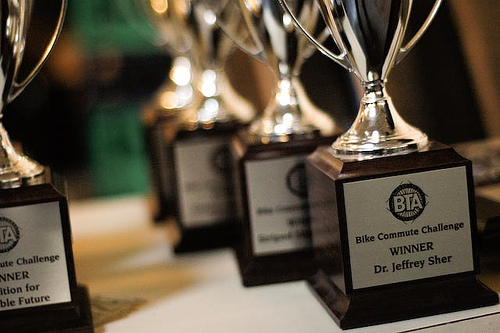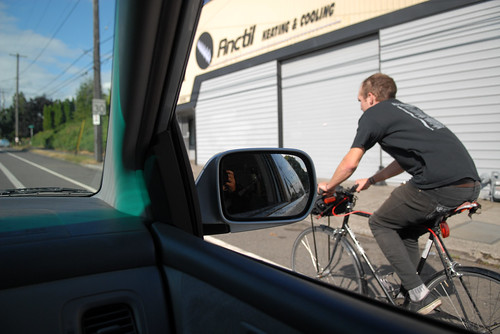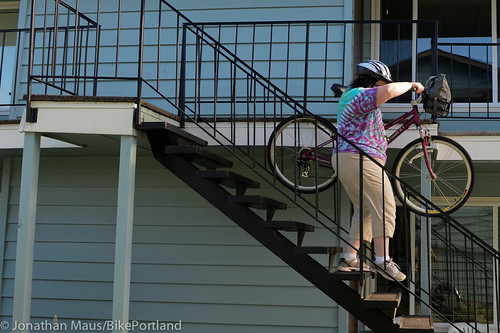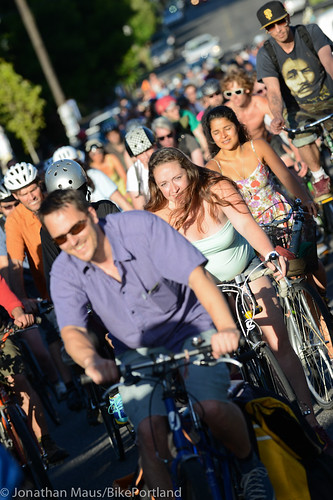Portland’s friendly annual competition among workplaces to see who can log the most and longest bike trips and who can recruit the most commuters starts today. And an excellent new academic paper shows exactly why you should be signing up and nudging your co-workers to do the same.
The paper published last week is by New York-based biking psychology student Do Lee, based on interviews, mapping and video and ride-along observations of the two-week Lake Tahoe Bike Challenge in California.
His simple conclusion: no amount of infrastructure or logic is ever going to give people the confidence and information they need to make a rational decision about whether they should commute by bike.
For confidence, they have to see other people doing it — and for information, they simply have to try it.
Lee’s study, which won a “best student paper” award last year from his regional division of the American Psychological Association, is unfortunately behind a paywall. But we can share some key insights here that ring true.
Most people have no idea where bike infrastructure is located
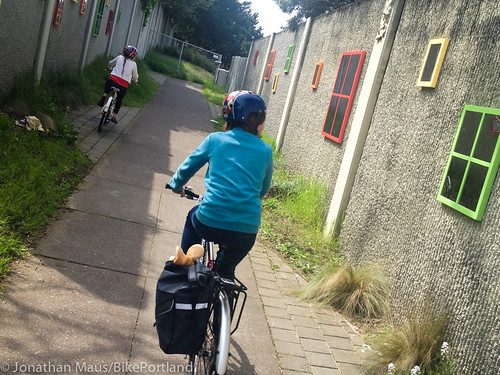
When I was considering a bike commute in 2009, I emailed a friend to ask how long he thought it would take to bike from the Arbor Lodge neighborhood in north Portland to my job in downtown Vancouver.
“I’m going to say it would take you about 15 minutes,” he replied. “Provided that the car you get rear-ended by on I-5 deposits your remains at your desired location.”
My friend (a Portlander if there ever was one) had driven to Vancouver before but had no idea that there is a bikeable path across the Interstate Bridge. And in that, Lee finds, he was like most people who have only taken a particular trip in a car.
“Many bicyclists prefer designated bike paths and informal bike trails but these routes are usually located away from the main roads and are often difficult to spot while driving,” Lee writes. “Prior to their first bike to work event, many participants lacked knowledge of bike routes other than those immediately visible while driving.”
For Portland’s bike network, which is dependent on our generally pleasant but hard-to-spot neighborhood greenways, this hurdle is especially high. But the practical experience of piecing together a bike commute for the sake of workplace camaraderie can break it down, Lee writes.
People driving see only the worst parts of bike commuting
Most people who commute by car come across people biking from time to time. Where are they most likely to do so? During the very worst moments of a bike commute — the moments when the bike commuter has to interact with cars.
Is it any wonder that so many car-centric people see bikers, and biking, at their worst?
In his interviews, Lee found that people thought biking is always like that.
“In essence, the participants forecast an experience of bicycle commuting that is filtered through their experiences of driving,” he writes. “The driving environment renders the positive aspects of bicycle commuting invisible while drivers simultaneously project negative qualities onto any bicycle commuting that remains visible.”
Only by escaping the car for a day or two can someone understand that a lot of bike commuting is actually less stressful than driving.
Advertisement
Rich and poor people alike are motivated by more than just money
There’s a popular myth that some people who don’t own cars bike because they “have to.” But people of every income level are making choices all the time. Someone who doesn’t own a car might carpool, ride a bus or simply make painful financial sacrifices to buy a car.
Lee’s research suggests that you don’t have to be an office worker to respond to a bike-to-work challenge.
“The two Latino males in this study were both blue-collar laborers who worked multiple jobs; yet, both spoke of becoming bicycle commuters not out of economic necessity, but based on complex experiences and motivations facilitated by the event,” he writes. “Based on their interviews, both participants would not have known about and experienced the event without having a workplace team.”
On the downside, Lee found, bike-to-work events often end up targeting office workers, neglecting people who work other jobs and ignoring people who focus on unpaid work like parenting.
“The event did not exclude anybody from participating, but the event’s outreach favored the social environments of middle class, well educated, and mostly white social networks in Tahoe despite a sizeable local Latino bicycling population,” Lee writes.
Moral of the story: Bike lanes aren’t nearly enough
Bike infrastructure is great for those of us who already ride. But it does little to boost the number of people biking unless people get on their bikes for the first time — and getting people on bikes requires social support.
“Bicycling infrastructure alone is not enough to encourage cycling, because the material and social conditions of a car world render bicycle commuting as largely invisible and unviable for everyday transport,” Lee writes. “Lived experience is the essential bridge to knowing how one’s environment affords bicycle commuting in daily life.”
As we’ve reported, the Bicycle Transportation Alliance’s free-to-play competition has been steadily shrinking since 2011. But the BCC’s major funders at Metro doubled down in 2015 by boosting their support for the program.
Let’s hope it works. There’s little question that the BCC has played a big role in helping thousands of Portlanders discover the joy of bike commuting.
“Real freedom is about breaking from automatic and unconscious habits and routines in order to search for new possibilities of being in the world,” Lee writes, quoting the late philosopher Maxine Greene.
Here’s to that.
Thanks to Jessica Roberts, a bike programming expert at Alta Planning and Design, for the tip about Lee’s work.
